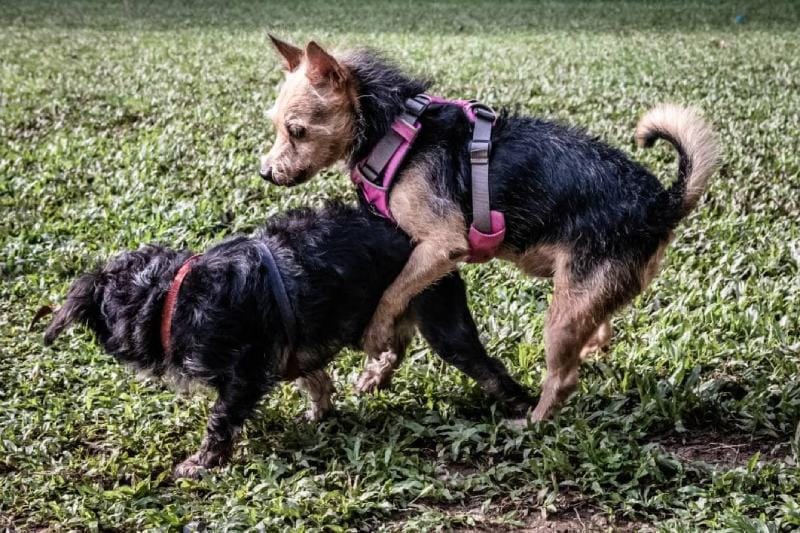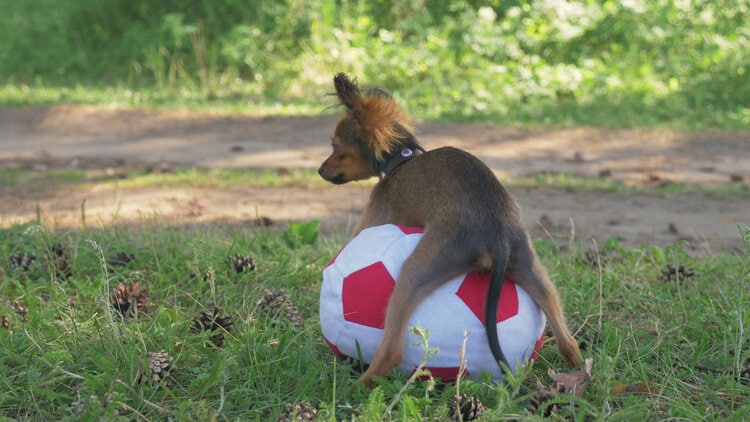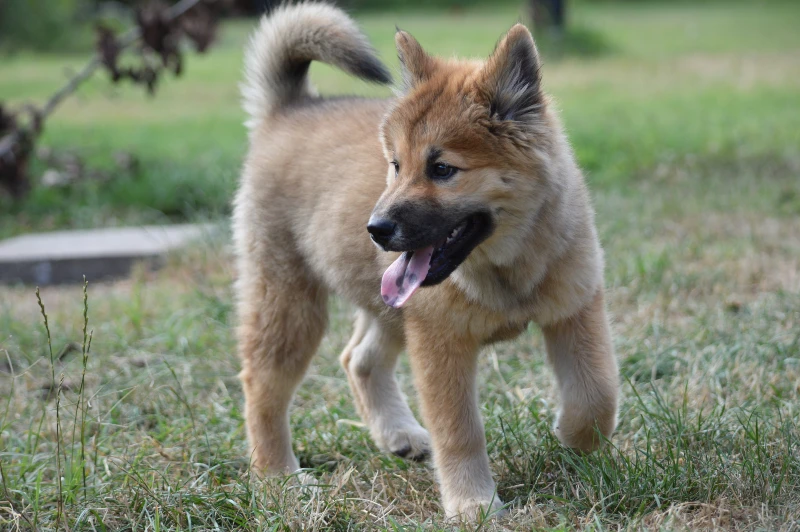Why Do Puppies Hump? 7 Vet Reviewed Reasons & What to Do
Updated on

Click to Skip Ahead
What will cause a dog owner to turn the color of a ripe tomato in a few seconds? Humping.
Dog humping is a normal part of dog behavior. But that doesn’t make it any less awkward, especially when your dog seems to have a favorite dog or person to “practice” on.
In this post, we’re discussing six common reasons why puppies hump and what you can do to keep your dog (and you) from becoming the laughingstock of the dog park.
The 7 Reasons Why Puppies Hump
1. An Act of Dominance
More often than not, humping is an act of dominance rather than sexual. Your puppy takes charge by putting itself on top of the other dog (or person). This isn’t always a bad thing. In fact, many puppies do this when cheerfully playing with other dogs as their own unique way of saying, “I win.” It is worth noting that even female dogs will hump.

2. Rehearsal Behavior
In very young puppies, usually under 4 months old, behaviors like humping, fighting and even playing, are referred to as “rehearsal behaviors”. This basically means that they are practicing behaviors that are not necessarily relevant or serious at that life stage, but will potentially be needed later in life. The humping isn’t sexual in nature, but their bodies are “going through the motions” as they develop.
3. Too Much Stress
When dogs endure too much stress, they try to release it in several ways, including humping. It’s a self-soothing action that releases tension. Being away from home, a new schedule, a guest, a new baby, or a new pet can all stimulate humping.

4. Overstimulation
When the excitement is too much, sometimes puppies get the zoomies, other puppies pee, and other puppies will often hump for joy. It’s strange to us, but not uncommon in dogs.
5. A Male Medical Issue
At times, humping can point to a male medical issue like prostate problems, infection, or irritation. Depending on the disorder, prostate concerns can occur in intact and neutered dogs. Your dog may lick its groin in addition to humping if this is the case.

6. Canine Compulsive Disorder
Canine Compulsive Disorder (CCD) is when a dog uncontrollably thinks about or does something repeatedly. This is usually done at an extreme level and causes a disruption in normal activity. Dogs with CCD have their own quirks, and humping can be one of them.
7. Hormones
Last and certainly not least, humping is a sexually arousing act. It’s more common in younger dogs that are intact since they have a higher sex drive, and they are just starting to experience new urges and sensations.

When Is Humping a Concern?
If your dog occasionally humps and it’s not a concern for you or others, there’s nothing to worry about. Humping is a normal dog behavior that humans will never truly understand because we’re not wired the same way.
With this in mind, it’s best to teach your dog other healthy behavioral outlets so you can avoid those awkward situations when you have a visitor or are having fun at the dog park. Lots of dogs hump, but that doesn’t mean they want to be the dog being humped. This can lead to dog fights if you’re not careful.
Other times to be concerned are when the behavior is compulsive or seems to have started out of the blue.
Compulsive behavior means it’s difficult for your dog to stop and interferes with daily life. Usually, the behavior is out of context. Any dog that is overly anxious and stressed can experience compulsive behavior.
If the behavior is out of the blue, it may be time to visit the doctor to rule out any medical issues.
The one type of humping you shouldn’t necessarily try to stop is the rehearsal type. It is normal and natural for young pups to be learning and exploring, and this is all part of the process. If they hump other dogs, this is the age that they will likely be told off in a more restrained way, so it is good for them to learn while other dogs will be more patient with them. That being said, if they get a bit carried away with the leg humping, it’s worth putting a stop to it if it goes on too long. It’s all part of the fun of learning!

 How to Stop Your Dog From Humping
How to Stop Your Dog From Humping
To keep your dog from humping, you’ll need to catch him doing the act, so it can take a while before your dog learns. Here are a few ways you can keep the humping to a minimum:
1. Distract Your Dog
Some dogs get that hot-and-heavy look in their eye when they’re about to hump. Typical signs include panting, pawing, rubbing against the dog or person, licking, and whining. If you notice these signs, immediately distract your dog with a toy, treat, or have him perform a trick.
Keep in mind that you should not reward your dog for humping, you should reward him for stopping, so make sure the treat is not given immediately after stopping humping.
2. Take Your Dog to a Quiet Area
Sometimes catching your dog in the act is tough. If you can’t prevent the behavior, remove your dog and take him to a quiet space to decompress for about 10 minutes.

3. Minimize Stress (Look for Patterns)
If the humping is stress-related, there will be breadcrumbs to follow. Does your dog only hump when there’s a new visitor or a specific visitor? Was there a recent change to your dog’s daily life that’s upsetting him? Look for patterns and try to minimize the stress as much as possible.
4. Neuter Your Dog
An easy fix to a sexually driven humper is to neuter. Luckily, neutering doesn’t have to be expensive. Plenty of low-cost options will work with you and your budget to provide the best care for your dog. Be careful to distinguish between “rehearsal” humping and genuine humping, as neutering a dog too early can really disrupt their physical and behavioral development. Most vets recommend waiting until dogs are at least 6-12 months old before neutering. even older in larger breeds.

5. Rule Out Medical Issues
Book an appointment with your veterinarian if you’ve ruled out all other concerns and the behavior continues. Your veterinarian will most likely recommend some bloodwork and an ultrasound of your dog’s prostate to aid in a proper diagnosis.
6. Find a Behaviorist
Training a dog is hard, hard work, and sometimes, unwanted behavior needs professional help if all of the above have not yielded success.
Conclusion
Now that you know what causes humping, ask yourself if it’s worth worrying about. Most of the time, humping is perfectly natural, no matter how embarrassing it can be for us, but sometimes, humping warrants a trip to the vet or an appointment with a behaviorist.
If your dog is humping, try the tips listed above and see if you notice any changes to your dog’s behavior. If not, consider calling in the pros.
Featured Image Credit: Spik and I, Shutterstock











